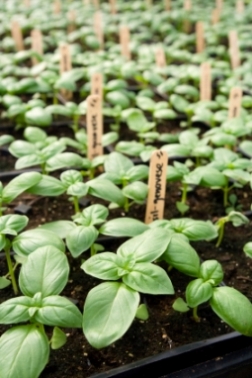Genovese Basil
Genovese Basil is often referred to as Italian Basil because it is a common ingredient used to add flavor to Italian food. Other names that you might see are Sweet Basil or Common, since this is the most common variety. Chances are that this is what you will find most prominently at your local grocery store or farmers' market.

Have you grown, tasted, cooked with or had any experience at all with this basil variety? If you have, I'd love to hear about it! share your experience here.

This variety has dark green, shiny leaves that tend to curl under as the leaves grow in size. The plant will produce long stalks of small white flowers. This plant will grow to about 3 feet high.
Genovese Basil is considered a sign of love in Italy. An old legend says that when a woman put a pot of this herb on her windowsill it was a sign that she was ready to receive a suitor.
Another legend says that if a man gives a woman a sprig of sweet basil herbs it means she will fall in love with him forever.
The leaves have a lovely anise or licorice scent and the taste is most often referred to as sweet and slightly peppery. This herb makes a lovely addition to an herb garden. It is also one of the most versatile herbs for cooking.
In an herb garden, the flowers should be pinched off to promote more leaf growth. This variety tends to produce a very high yield of leaves, especially when the flowers are pinched. If you let the flowers bloom, the leaves will lose most of their flavor and the plant will go to seed and die off.
In the kitchen, you can add this herb to just about anything, especially dishes with typical Italian ingredients such as pasta and tomatoes. In dried form, this is one of the main ingredients in Italian Seasoning, which you are likely to find among most household spice collections.
Like most varieties, Genovese Basil is a perennial in warm climates but grows as an annual in climates with colder winter months. This plant is very susceptible to cold and will not survive a cold winter unless brought indoors.
You can easily start your plant from seed over winter and transplant the seedlings outdoors well after the last chance of frost. If the plant is touched by frost the leaves will turn black and the plant may not survive. You will be able to find sweet basil seed in any seed catalog. Since this is the most common variety, it is also readily available in plant form at your local nursery.
Share Your Experience
With Genovese Basil
Have you grown or tasted Genovese Basil? Tell us what you thought!






New! Comments
Let's hear from you! Leave me a comment in the box below.